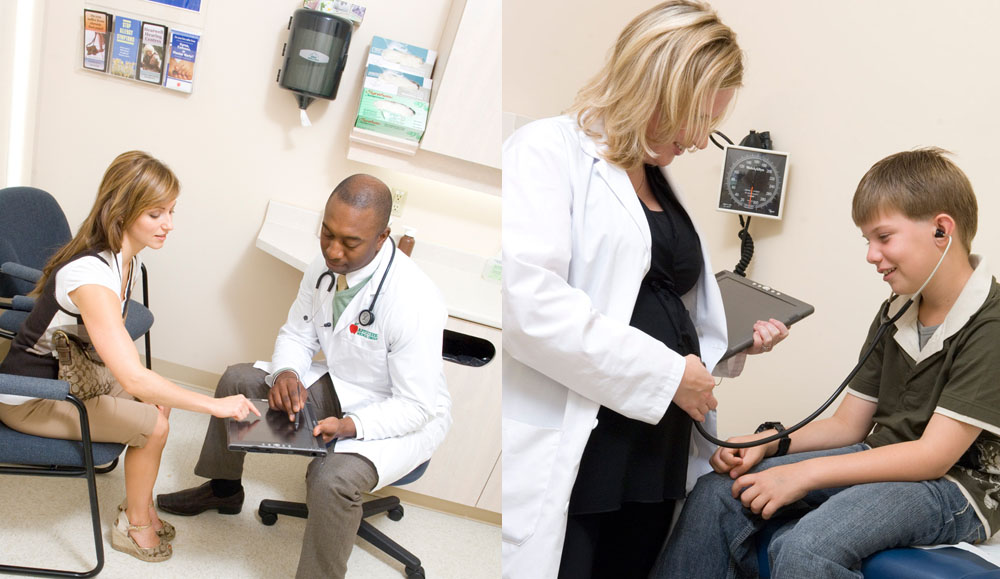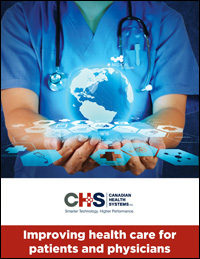Improving health care for patients and physicians
By Cheryl Long
When the Ontario government introduced a program in 2009 subsidizing doctors who were willing to transition from paper to Electronic Medical Records (EMRs), it was expected that patient care and medical practice efficiency would improve as a result. It seemed like the ideal way to encourage widespread adoption of technology into the health-care system but problems soon began to surface.
Rather than using the subsidy to choose the best systems for their practice, some doctors opted to generate extra revenue by purchasing less expensive EMR software from an approved vendor list. Some systems were difficult to learn or cumbersome to use; others worked off a template format that could miss important patient details. Most systems were set up for use only on a desktop computer and monitor, which meant that doctors would be trying to listen to patients while typing away at a keyboard.
“By over-subsidizing relative to the cost of the systems, it led many doctors to choose systems that had the least impact on them instead of choosing ones that would actuallychange workflow and have the greatest list of benefits to their practice,” said Dr. Thom Tyson, President and CEO of Canadian Health Systems (CHS) Inc.
Though the premise of moving health care into a more technologically-savvy place was a good one, the outcome was less than ideal.
Developing a better EMR platform
The team at Canadian Health Systems Inc. knew that they could offer a better EMR platform; one that would not only reduce expenses and streamline medical practice operations through automation but would also allow physicians to refocus on the reason they entered the profession — their patients. The Ontario-based company was already experienced in bringingrevolutionarytechnology to the health-care field. Seventeen years ago, they introduced the first self-registration kiosks into Canadian healthcare, allowing patients to self-register for their appointments upon arrival. The kiosks evolved to increase patient engagement in their own health care while providing additional benefits such as language options, enhanced privacy and safety measures that could flag infectious symptoms.
“It’s all about the practice environment for the purpose of improving medical care for the patients,” Dr. Tyson said. “When you develop technology, you have to keep in mind how is this enabling all three parts of the office, the patient, the staff and the doctor, to work in harmony better.” The result is the highest rated EMR system in Ontario, according to the OntarioMD website.
Funding through the EMR Adoption Program (operated by OntarioMD, a subsidiary of the Ontario Medical Association) ended in March and that’s not necessarily a bad thing, Dr. Tyson said. These days, physicians are looking for better systems that will actually pay for themselves whileadding value to their practices and improving office function.
Realizing that many of today’s older doctors were trained to record their findings using pen and paper, the CHS team knew that the ideal EMR system needed to be easy to use, provide connectivity and allow physicians to write, type or speak, directly to the system. More importantly, it had to be mobile. Studies were showing that the desktop computer/keyboard combination was not only costing doctors’ 20% more time than mobile tablets but it is also very difficult to type and listen effectively at the same time.
“…that’s why they’re starting to ban laptops from university classrooms,” Dr. Tyson explained. “However the brain has evolved over millions of years, it seems that people are able to listen while holding a chart and jotting a few notes but they can’t give you their full attention and capture the context of a case while typing actively.”
Tablet-based system easy to use
EMR Advantage by CHS is a fully-integrated, tablet-based EMR system that is easy to use without sacrificing the more sophisticated tools needed to run an efficient medical practice. Its features provide options for billing, chronic disease management, EMR dictation, consult requests, electronic lab results, prescription management, hospital reports and much more. Ultimately, by helping medical practices improve the bottom line, doctors have more resources that can lead to improvements in patient care.
The system also allows for existing patient charts to be captured electronically, cutting down on the amount of storage needed for paper records. When physicians switch to the tablet, they discover an electronic chart designed similarly to the paper version. There’s no need to spend time learning how to operate a new charting format, going back to the ease of use component that was a priority when CHS developed the system.
“If it isn’t easier to use, if it doesn’t allow doctors to simply practice better medicine and focus onthe patientswhile automating the office workflow, you’ve squandered the promise of going digital in the first place,” Dr. Tyson said.
Whether a doctor is operating a solo practice or has joined a group health centre, the benefits of using a better designed EMR are many: increased net income, better workflow through automated processes, fast and accurate automated billing,reduced office operating expenses and more efficient charting, whether by writing, typing or speaking. Another key feature is the system’s minimal learning curve, designed with busy doctors and medical office staff in mind.
“There aredifferent levels of computer literacy and we have to suss that out — at the administrative level, at the physician level, at the nurse level,” said Hayley Kash, Director of Operations for CHS. “Once we assess those different levels, the goal is 100-percent meaningful use.”
Up and running in an hour
In fact, CHS says that they can introduce EMR Advantage to a 70-year-old physician and have the doctorup and running in an hour. By the third lesson, EMR Advantage is being used to run the entire practice.But it doesn’t end there. Because technology is always evolving, CHS maintains a continued relationship with each client, assisting with troubleshooting, providing retraining when needed, assessing the system’s efficacy and returning to upgrade or install new versions.
Connectivity is another area that is crucial when it comes to running an effective EMR system. Physicians rarely just work out of their office or hospital; many will go online at home to check results or patient records. But the reality is that in any location, internet connectivity can either slow down or be dropped completely. For that reason, CHS architected a “boosted cloud model” that runs locally but connects to the cloud in real time. That allows physicians and medical staff to keep working even with an internet outage and when the connection is re-established, the data updates itself and no information is lost.
Practices that have adopted EMR Advantage are finding that the system is a draw for physicians looking for a better practice environment. “You’ll see in advertisements, in medical publications, that our clients are listing ‘We use EMR Advantage’ because they know that is a proven attractant to high quality doctors who want to spend more time doing medicine and less time playing around with complex technology,” Dr. Tyson said.
Their favourite client, Kash said, is the “reluctant doctor”, typically the doctor who has tried to use another software platform and has run into issues. CHS wants to know what made the process difficult: where were the bottlenecks, what were the stop gaps? “That way we can individualize and address how to effectively train and deploy that client,” she explained. Those types of situations also help CHS customize and evolve the system, a service that Dr. Tyson describes as being “in our DNA”. “Most EMR companies run away from customization,” he said. “We embrace it. Different groups and specialties have their own unique perspectives; we are very attuned to addressing those needs”
To learn more about CHS and the EMR Advantage system, visit www.chsinc.ca.







